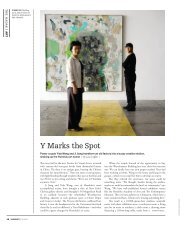The Scholarship of Teaching and Learning: TheoryâPractice - NAIRTL
The Scholarship of Teaching and Learning: TheoryâPractice - NAIRTL
The Scholarship of Teaching and Learning: TheoryâPractice - NAIRTL
You also want an ePaper? Increase the reach of your titles
YUMPU automatically turns print PDFs into web optimized ePapers that Google loves.
<strong>The</strong> <strong>Scholarship</strong> <strong>of</strong> <strong>Teaching</strong> <strong>and</strong> <strong>Learning</strong> 11<br />
Evaluations<br />
Process Evaluations (Q’s 1–4). Prior to the program, data had been<br />
gathered as part <strong>of</strong> a prior learning assessment interview (Hubball,<br />
2001; Kolb, 1984; Pratt & Collins, 2000). Once the program started,<br />
various data sources were compiled to examine faculty participants’<br />
progress <strong>and</strong> completion <strong>of</strong> FCP learning outcomes, including a review<br />
<strong>of</strong> program portfolios, formative program evaluation questionnaires,<br />
mid-program formative assessment interviews, <strong>and</strong> analysis <strong>of</strong> video<br />
recordings <strong>of</strong> peer-teaching workshops. Furthermore, before <strong>and</strong> after<br />
each cohort meeting, facilitators engaged in reflective dialogue to<br />
plan on-going learning activities <strong>and</strong> assess progress, strengths <strong>and</strong><br />
weaknesses <strong>of</strong> FCP learning experiences (Altrichter et al., 1993;<br />
Bullough & Pinnegar, 2001; Robertson & Hubball, in press).<br />
Impact Evaluations (Q’s 5–7). On completion <strong>of</strong> the UBC FCP,<br />
facilitators analyzed data from summative program evaluation questionnaires,<br />
focus groups, <strong>and</strong> semistructured interviews with faculty<br />
participants in order to assess the quality <strong>of</strong> the overall program<br />
experience (Bogdan & Biklen, 1992). In addition, faculty members were<br />
required to rate (on a scale <strong>of</strong> 1–5) the perceived usefulness <strong>of</strong> various<br />
learning strategies in the FCP.<br />
Follow-up Evaluations (Q’s 8–11). Facilitators analyzed one-year<br />
follow-up data to assess the long-term impact <strong>of</strong> the program <strong>and</strong><br />
whether <strong>and</strong> how learning was applied. Data were gathered from<br />
responses to e-mail messages that were sent out to all faculty members<br />
in the 2002–03 cohort (n = 24). Twenty-two participants responded<br />
to this survey. Furthermore, follow-up telephone interviews were<br />
conducted with a focus group sample <strong>of</strong> 50% <strong>of</strong> all respondents. Finally,<br />
minutes from the FCP advisory board meetings were used to highlight<br />
progress, critical aspects that influenced program implementation, <strong>and</strong><br />
strategic planning goals for the FCP.<br />
Facilitators analyzed qualitative data for common <strong>and</strong> isolated experiences<br />
<strong>and</strong> for major themes (Lincoln & Guba, 1985; Strauss & Corbin,<br />
1998). Quantitative data, on the other h<strong>and</strong>, were analyzed using<br />
descriptive statistics <strong>and</strong> recorded as frequency counts, means, <strong>and</strong><br />
st<strong>and</strong>ard deviations. <strong>The</strong>se numeric indicators were particularly useful<br />
for providing simple comparative data (e.g., categories <strong>of</strong> learning style<br />
preferences within the faculty cohort), as well as another lens through<br />
which to analyze the efficacy <strong>of</strong> formative <strong>and</strong> summative program<br />
evaluations. Since a more in-depth analysis was not the purpose <strong>of</strong> this<br />
study, the intention here is to provide a broad set <strong>of</strong> data against which<br />
to view process, impact, <strong>and</strong> follow-up evaluations.











